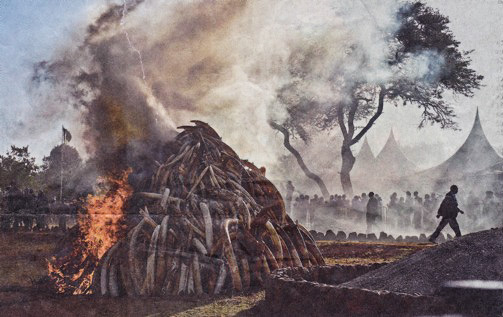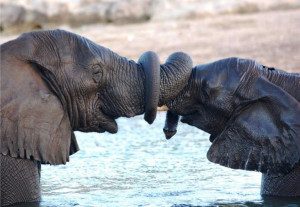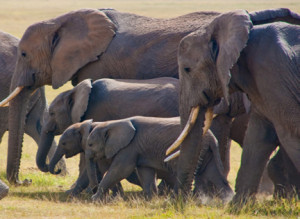June 16, 2015
The Honorable Fran Pavley
Senate Natural Resources and Water Committee
State Capitol — Room 5046
Sacramento, California 95814
RE: Assembly Bill 96 (Atkins)
Position: OPPOSE
Dear Chairwoman Pavley:
On behalf of the Ivory Education Institute I am expressing our opposition to AB 96. The Ivory Education Institute is headquartered in Los Angeles and is dedicated to enhancing understanding of the cultural importance of ivory.
In our view, AB 96 cannot save one elephant in Africa — but it will hurt millions of Californians who own and have inherited ivory heirlooms over the years.
- The market for illegal ivory products is overwhelmingly in East Asia — certifiably not the U.S. To punish Californians for having something that had been legally obtained and has been of immense artistic, practical, scientific and cultural importance since before Biblical times is tantamount to the Taliban’s desecration of Buddhist statues in Afghanistan and the Islamic State’s destruction of artifacts in Iraq.
- How can banning all trade in important cultural artifacts carved from fossilized walrus or from mammoth and mastodon tusks — animals that have been extinct for tens of thousands of years — have anything reasonably or realistically to do with saving African elephants today?
- Why is it that expert opinion is good enough to determine the authenticity of paintings that the Getty, LACMA and other museums buy for hundreds of millions of dollars, but it isn’t good enough to determine the age, type, or provenance of objects made from or with ivory?
- How is it fair to throw millions of ordinary citizens who have inherited or preserved ivory pieces under the bus, but allow musicians and museums to keep, use and trade their ivory objects unhampered by the Government of California?
- Why hasn’t anyone demanded evidence from animal rights extremists that banning ivory in California is the most important thing to be done to save African elephants that the activists claim are about to become extinct?
Of course this point demands a further question. Are elephants really about to become extinct?
- An estimated 15% of the elephants that extremists say are “killed” by poachers each year are actually dying from other causes. Old age, overcrowding, disease, and accidents catch up with elephants just as they do with humans. Other animals are legally hunted as a source of food in villages and culled to prevent land destruction or overcrowding.
- In southern Africa today, the size of elephant herds are growing in part because managed conservation techniques can balance the needs and interests of local communities with those of the elephants. Once locals begin appreciating the benefits of wildlife tourism, they gain a major economic stake in protecting their animals. Soon, corruption decreases, herds grow and a reasonable balance between man and animal is achieved.
- Researchers for the UN Environment Programme, Interpol, and the Ivory Education Institute all conclude that terrorism is not an integral aspect of wildlife trafficking in Africa. There just aren’t enough elephants in the areas where al Shabab, Boko Haram, the Lord’s Resistance Army and other extremist groups operate to support their financial needs, especially in light of other available more lucrative illegal activities.
Worse, AB 96 assumes that cutting off supply in California will somehow end demand in East Asia. History shows us how other examples of this type of wishful thinking has become failed government policy.
- Prohibition didn’t stem the supply of alcohol or stop drinking; on the contrary, both increased dramatically.
- The War on Drugs hasn’t ended marijuana and cocaine use in our society; they are still doing damage on the streets of America.
- Illegal immigration hasn’t stopped with a fence or increased surveillance technology; it is still going on.
The solution to the ivory question is rooted in managing demand rather than in stopping supply. Specialists involved with ivory believe that a consistent, controlled marketplace for ivory — using tusks in storage, from animals that die of natural causes as well as hunting and culling activities, and ivory that has been recycled — would allow for managed conservation techniques, establish a stable pricing mechanism to satisfy demand, and allow ivory to assume its historic role in our culture.
What follows is a response to the analysis prepared by the Assembly Water, Parks and Wildlife Committee staff for the hearing on 10 March 2015.
1. “it is very difficult to determine the age of the ivory.”
This is a total myth. No appraiser, artisan, auctioneer, antique dealer, conservator, collector or curator that handles ivory on a consistent basis has any difficulty determining its probable age, type, or provenance. Moreover, the Ivory Education Institute has sponsored a scientific project to provide government authorities with a non-invasive, non-destructive, inexpensive and quick means of determining the age and type of any ivory or ivory-substitute material. The State of California should be supporting this type of research rather than giving up because the task seems “difficult.”
2. “growing demand for elephant ivory … is causing prices to soar for these illegal commodities and the black market for poachers trading in these illegal goods to thrive.”
Most serious and knowledgeable authorities such as Dr. Dan Stiles and Dr. Brendan Moyle (Stiles — a Californian, lives in Kenya and has worked for the UN, most of the NGOs, and now heads a project to protect small apes in Africa. He conducted the NDRC survey that AB 96 is based on. Moyle is from New Zealand, teaches economics at Massey University, and is dedicated to saving endangered species in Africa) believe that ivory prices in Asia have increased because the supply of raw ivory to the 27 legal factories in China has been so uncertain. Rather than providing a consistent supply of tusks from legal sources that the legitimate market can rely on, the market is dependent on erratic releases of legal ivory, existing inventory, recycled pieces, and smuggled ivory that has corruptly been legitimized. Lower prices resulting from a consistent, regulated and legal supply would eliminate the high profit incentive attracting poachers.
3. “The United States is one of the largest consumers of illegal ivory in the world,”
Another myth. CITES (the Geneva-based organization enforcing the Convention on International Trade in Endangered Species) has praised the U.S. for the tiny amount of illegal ivory coming into its markets. The latest figures suggest that ICE has confiscated a few pounds of ivory in the last several years, not from professional smuggling operations, but most likely from hapless tourists bringing home a souvenir.
4. “California is the second largest U.S. retail market for illegal ivory behind the state of New York.”
This statement sounds worrisome, but it is full of holes. Given the fact that California — with 38.8 million inhabitants — has nearly twice the population of the State of New York (19.75), being second means it is actually miles behind. Then there is the question of how the illegal ivory statistics were developed. We don’t know about New York’s methodology, but we know that California’s “illegal” market is based on a survey conducted by Dan Stiles. He was asked by the Natural Resources Defense Council to visit antique shops, flea markets, auction houses, and the like in Los Angeles and San Francisco to determine the number of items that were “potentially” worked before 1977. As he himself notes, there is a huge quantitative gulf between “potentially” and “probably.” Anyone wanting to cook the numbers can fit nearly everything seen under the rubric of “potentially” while it takes judgment, care, and some demonstrable evidence to make a finding of “probable.”
5. “On average, 96 elephants per day are brutally killed for their ivory, translating into an average of over 35,000 elephants per year.”
The World Wildlife Society has a major public relations program called the 96 Campaign and Speaker Adkins had her bill assigned the number 96 to hammer home the message that 96 elephants die per day from poachers. Yet no one has provided a shred of evidence that the number is valid. Those who conduct elephant censuses admit the difficulty of finding the herds in the forest to do an actual count. So they rely on a mixture of calculations based on water hole sightings, dung droppings in particular areas, carcasses found, habitat destruction, historical data, and other guesstimates to estimate elephant populations from year to year. The fact that a decrease in any particular herd might be from natural causes is an inconvenient fact that zealots choose to ignore. While poaching is certainly occurring in north central Africa, the fact that elephant numbers are growing in southern Africa is never mentioned. Finally, the fact that 35,000 elephants would produce 70,000 tusks and the tusks would very conservatively weigh about 10-pounds each, there would be 700,000 pounds of ivory coming into the market each year. Where is it? Who is working this volume of ivory and where are the finished products being sold to sustain continuous buying of this amount? No one has seen anywhere near this amount of ivory — equivalent to the weight of 5 space shuttles or two Victorian houses. Why are those perpetrating this myth of 96 elephants being “brutally killed” each day for their ivory being given a free pass when it comes to the evidence for this highly suspect statement?
6. “according to the usfws … [the] legal ivory trade can serve as a cover for illegal trade. as one example, usfws and state officers seized more than two million dollars of illegal elephant ivory from two new york city retail stores in 2012.”
While the US Fish and Wildlife Service always notes this case, it is the ONLY such recent case on record. Rather than being an example of uncontrolled smuggling into the U.S. to satisfy a rampaging demand for ivory products, it is an isolated case of two loose canon merchants who tried to bring in goods from the Far East without the proper paperwork. There are no other cases of any size to support the assertion that the U.S. is a hotbed for smuggled ivory. Moreover, the Assembly analysis accepts another phony concern of the USFWS: “[B]y significantly restricting ivory trade in the United States, it will be more difficult to launder illegal ivory into the market and thus reduce the threat of poaching to imperiled elephant populations.” Since there is so little proven poaching product coming into the United States, ivory laundering — making new pieces appear old — is almost non-existent.
7. “numerous news outlets have reported on suspicions (emphasis added) that ivory poaching is becoming a growing source of funding for several terrorist organizations, including the janjaweed militia in sudan and the lord’s resistance army in uganda, and possibly including terrorist groups in Somalia.”
Please. How credible is an analysis that finds “numerous news outlets” (unnamed) have reported “suspicions” (based on what other than thin air assumptions) that poaching could be a source of funding. The Ivory Education Institute engaged Dan Stiles to conduct a study in 2014 on the link between poaching and a threat to U.S. national security. Dan found that “the evidence that … elephant poaching [is used} to finance … terrorist activities … lacking credibility.” The Speaker can’t have it both ways — relying on Dan’s California survey to project the danger to elephants in Africa and then rejecting Dan’s conclusions concerning the danger of poaching to U.S. national security.
Bottom Line
Putting aside all other arguments, the fundamental fact is that there is absolutely no correlation between the trade and movement of ivory objects in California and the well being of elephants in Africa. Moreover, the rules for ivory ownership settled in 1977 are now being changed without justification. The claim in a Los Angeles Times editorial (June 8, 2015) that “the bill will not go into effect until July 2016. So anyone who wants to sell something will have more than six months to do so.” Either the Times knows nothing of the fire arts marketplace or someone is looking to make a killing in a fire sale marketplace. To ban all ivory — including ancient mammoth and fossilized walrus along with plentiful warthog, boar, and hippo ivory — in the hope of helping African elephants is ludicrous. To deprive Californians of their legitimately obtained property and to render its value in the open market worthless is probably an unconstitutional “taking” at best and unfair in the extreme.
For these reasons the Ivory Education Institute urges you to oppose AB 96.
Sincerely
Godfrey Harris
Managing Director
Ivory Education Institute

 LOS ANGELES
LOS ANGELES Only someone who hasn’t been paying attention would miss the answer to these questions. It is
Only someone who hasn’t been paying attention would miss the answer to these questions. It is  What a combination: Admired wild animals threatened by greedy, uncaring humans are saved by the concern of government leaders across the country. Impressive, but basically a
What a combination: Admired wild animals threatened by greedy, uncaring humans are saved by the concern of government leaders across the country. Impressive, but basically a